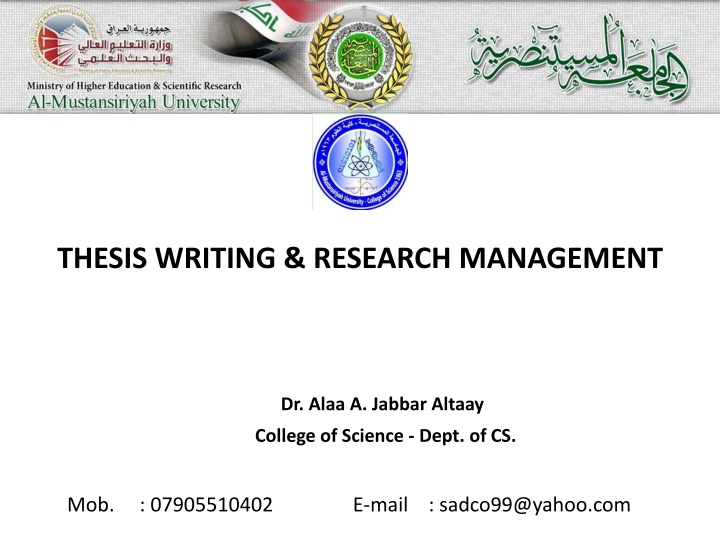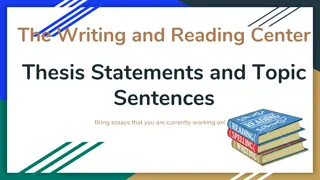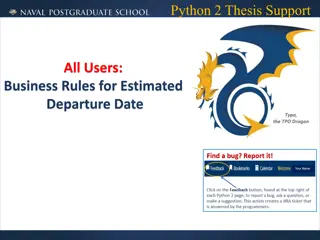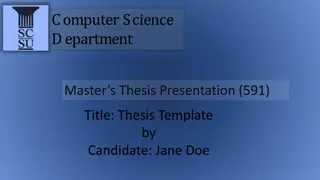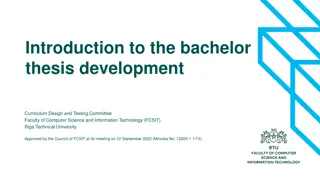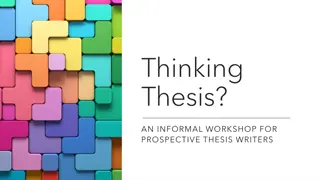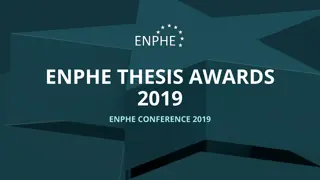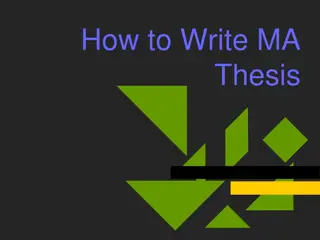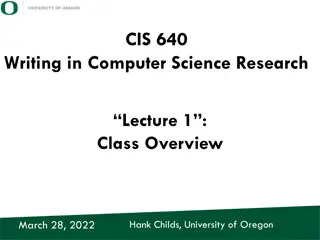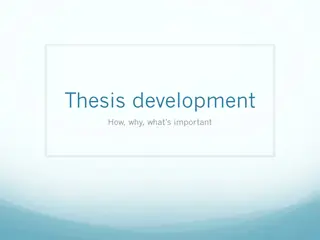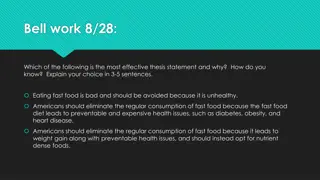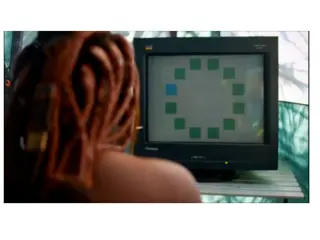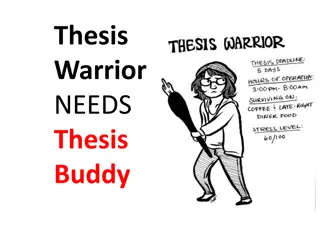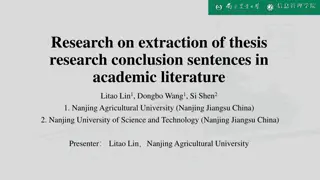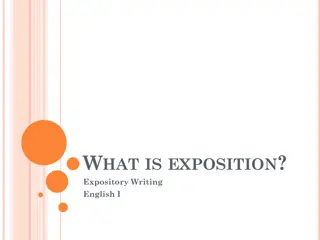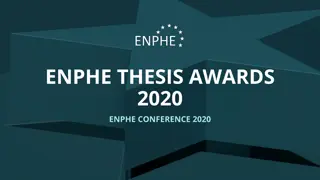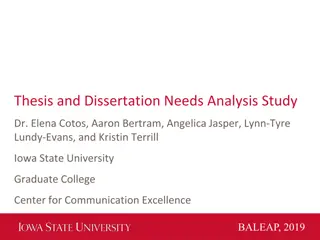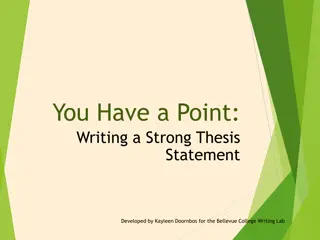THESIS WRITING & RESEARCH MANAGEMENT
This content covers attributes of a good thesis, common mistakes in writing citations, managing research activities, and more. Explore the processes and techniques related to thesis writing and postgraduate research management.
Download Presentation

Please find below an Image/Link to download the presentation.
The content on the website is provided AS IS for your information and personal use only. It may not be sold, licensed, or shared on other websites without obtaining consent from the author.If you encounter any issues during the download, it is possible that the publisher has removed the file from their server.
You are allowed to download the files provided on this website for personal or commercial use, subject to the condition that they are used lawfully. All files are the property of their respective owners.
The content on the website is provided AS IS for your information and personal use only. It may not be sold, licensed, or shared on other websites without obtaining consent from the author.
E N D
Presentation Transcript
THESIS WRITING & RESEARCH MANAGEMENT Dr. Alaa A. Jabbar Altaay College of Science - Dept. of CS. Mob. : 07905510402 E-mail : sadco99@yahoo.com
A. THESIS WRITING ( 1 hour) 1)Attributes of A Good Thesis 2)A Generic Thesis Skeleton 3)Format of Thesis 4)Thesis Writing Tools 5)Common Citation Styles and Its Corresponding References Style 6)Common Mistakes in Writing Citations and References 7)Plagiarism 8)Quality of Thesis
B. RESEARCH MANAGEMENT (1 hour) 1) Research Management From Inception to Completion 2) Challenges Facing A Researcher 3) Decision Making in Research 4) Managing Tasks 5) Managing Resources Time, Finance, etc. 6) Getting Feedback 7) Working with Supervisor
LEARNING OUTCOMES: At the end of the lecture, the students/ Researchers should be: 1) 2) 3) able to define and write a good Thesis able to identify the quality of a written Thesis able to understand the process of managing postgraduate research activities
A. THESIS WRITING Thesis or Dissertation? US and UK definition difference Dissertation: Synthesizing already existing literature Posting your own thoughts Part of a Master degree To demonstrate good knowledge Thesis : ++ Adding to already existing literature Have to conduct your own research Original To contribute to the body of knowledge
A. THESIS WRITING 1)Attributes of A Good Thesis: It should has an attractive and specific title. It provides the reader with a map to guide him/her through your work good thesis flow. It should answer: So what? or Who cares? It avoids vague language (like "it seems"). It avoids the first person. ("I believe," "In my opinion"). It should be able to lead the reader toward the topic sentences? It should be adequately developed in the required length of the paper?
A. THESIS WRITING 1)Attributes of A Good Thesis: It avoids the first person. ("I believe," "In my opinion"). Active Passive Passive I completedthe test The test was completed by me "The test was completed." example of passive sentence: Cars will be made from plastic in the future. Here the focus is on cars -- not who makes them
A. THESIS WRITING 1)Attributes of A Good Thesis Proficient vs. Excellent Proficient Thesis Inspires the reasonable readers to ask Why and How? Excellent Thesis Inspires the reasonable reader to ask Why and How? and engages the readers in challenging or provocative research and displays a level of thought that breaks new ground.
A. THESIS WRITING Reader s Attention Level 2) A Generic Thesis Skeleton 1. Preliminaries 2. Aims and objectives 3. Literature Review 4. Model Creation 5. Research Methodology 6. Design of experiments 7. Data Collection 8. Data Analyses 9. Model Validation 10. Reporting Findings 11. Future Work 12. Ending Chapter 1 Chapter 2 Intro Chapter 3 Your own work in details Chapter n Chapter n+1 Summarize
A. THESIS WRITING 2) A Generic Thesis Skeleton 1. Preliminaries Abstract Contents Lists of Figures, Tables, Abbreviations and Mathematical Symbols Preface Acknowledgement Author's Declaration
A. THESIS WRITING 2) A Generic Thesis Skeleton 2. Aims and objectives Proof of need/ motivation Scope Limits of model 3. Literature Review State of Art highest level of development of particular time. Fundamental - theory
A. THESIS WRITING 2) A Generic Thesis Skeleton 4. Model Creation Hypothesis Development Hypothesis Testing 5. Research Methodology 6. Design of experiments Practical Questionnaire Simulation
A. THESIS WRITING 2) A Generic Thesis Skeleton 7. Data Collection Questionnaire Design Pretest, etc. 8. Data Analyses Analyses Verification 9. Model Validation Confirmation Large Scale Implementation
A. THESIS WRITING 2) A Generic Thesis Skeleton 10. Reporting Findings Summary of Novel Findings Discussion of Knowledge Boundary Conclusion &/Recommendation 11. Future Work Suggestion to inspire reader but not showing the weakness of the thesis 12. Ending References/Bibliography Appendix Index
A. THESIS WRITING 2) A Generic Thesis Skeleton It is acceptable for individual chapter to be self-contained, including their own introduction, methods, results and discussions, as is often the case where individual chapter being submitted for publication. However, in such thesis a broader/wide introduction to the whole thesis should be included to tie the chapters or sections together and to provide the framework for the whole thesis.
A. THESIS WRITING 3) Format of Thesis Refer to UoM Thesis Guildline (a) Language The thesis must be written in either English or Arabic. (b) Typing - MS word or text processor. (i) Font - size: 12, style: Times New Roman (ii) Spacing single paged, double spacing, .. (iii) Type Quality laser printer quality.
A. THESIS WRITING 3) Format of Thesis Refer to UoM Thesis Guildline (c) Margins top & bottom & right: 2.5 cm; left: 3 cm (d) Pagination begin 1st page on Chapter 1; the first page of all chapters will not be printed. Preliminary page i. ii. Iii. iv,... (e) Paper A4 (210 x 297 mm), white, 80 grams paper.
A. THESIS WRITING 4) Thesis Writing Tools (a) Word Processors - Microsoft Word + Mendeley - LATEX/ BIBTEX open source, free for download (b) References/ Bibliographic Software - EndNote - Reference Manager - BibTex
Comparison between MS Word and LATEX MS Word LaTeX Ease of Use Simple New commands, new learning curve Small document WYSIWYG Slower, Layout in a separate step Large doc with graphics Slower - Sporadic (automatic) saves Faster No time wasting on layout done once at the end Price + Availability Expensive and troublesome with citation manager-Endnote or Reference Manager Open source free to download Layout Quality Far from professional Professional layout Citation Manager Not include citation utility Seamless references database organization with BiBDesk
A. THESIS WRITING 4) Thesis Writing Tools (a) Word Processors - Microsoft Word + Mendeley - LATEX open source, free for download (b) References/ Bibliographic Software - EndNote - Reference Manager - BibTex
A. THESIS WRITING 5) Common Citation Styles and Its Corresponding References Style (i) Any thesis which makes use of other works, either in direct quotation or by reference, must contain a bibliography listing of these sources. Only works directly cited or quoted in the text should be included in the bibliography.
A. THESIS WRITING 5) Common Citation Styles and Its Corresponding References Style (ii) UoM follows the (Harvard System) for literature citation and referencing. In the text The year of publication appears within parenthesis after the author's surname if the latter forms part of a sentence; Altaay (2014) or Altaay and Aliraqi (2015) or, where there are more than two authors, Altaay et. al. (2015).
A. THESIS WRITING 5) Common Citation Styles and Its Corresponding References Style (ii) UoM follows the Harvard System for literature citation and referencing. In the text If several papers by the same author(s) and from the same year are cited, the letters a, b, c, etc. should be put after the year of publication; e.g. Chazdon and Ibrahim (1988b). If the author's surname does not form part of a sentence, both the authors surname and the year of publication appear within parenthesis; e.g. (Yakub & Chan, 1989).
A. THESIS WRITING 5) Common Citation Styles and Its Corresponding References Style (ii) UoM follows the Harvard System for literature citation and referencing. In the text In any particular sentence, if several publications are cited, the references should be cited in chronological order. However, if several publications of the same year are cited the references should be cited in alphabetical order and with single author taking precedence over joint authors.
A. THESIS WRITING 5) Common Citation Styles and Its Corresponding References Style (ii) UoM follows the Harvard System for literature citation and referencing. At the end of the thesis, All the references cited are listed in alphabetical order. There is no necessity to number the references. The bibliography should be double-spaced as with the rest of the text using font size 12.
A. THESIS WRITING 5) Common Citation Styles and Its Corresponding References Style (ii) UoM follows the Harvard System for literature citation and referencing. At the end of the thesis, The following bibliographic style must be followed: Reference from journals:- Kalotas, T.M. & Lee, A.R. (2010). A Simple Device To Illustrate Angular Momentum Conservation And Instability. American Journal of Physics, Vol. 58, pp.80 - 81.
A. THESIS WRITING 5) Common Citation Styles and Its Corresponding References Style (ii) UoM follows the Harvard System for literature citation and referencing. At the end of the thesis, The following bibliographic style must be followed: Reference from books:- Conn, E.E., Stumpf, P.K., Bruenmig, G. & Doi, R.H. (2000). Outlines of Biochemistry, 5th ed., New York: John Wiley & Sons.
A. THESIS WRITING 5) Common Citation Styles and Its Corresponding References Style (ii) UTeM follows the Harvard System for literature citation and referencing. At the end of the thesis, The following bibliographic style must be followed: Reference from conference proceedings:- Hassan, M.D. &. Norshimah, H. (2010). Designing of Primers For Cloning of Papaya Ringspot Virus Coat Protein Gene. Proceedings of the 8th National Biotechnology Seminar (Hasanah, M.G.: Khatijah, M.Y. & Marziah, M.), pp. 172-174.
A. THESIS WRITING 5) Common Citation Styles and Its Corresponding References Style (ii) UTeM follows the Harvard System for literature citation and referencing. At the end of the thesis, The following bibliographic style must be followed: Anonymous (authorless) reference:- Anonymous (2000). External Trade in Shourjah Flour And Shourjah Starch, 1985-1995. Agricultural Statistics, Baghdad. Planning Division, Department of Agriculture, Baghdad, Iraq.
A. THESIS WRITING 5) Common Citation Styles and Its Corresponding References Style (ii) UoM follows the Harvard System for literature citation and referencing. At the end of the thesis, The following bibliographic style must be followed: Publications of international bodies/agencies:- WHO (2010). Environmental Health Criteria 39: Paraquat and Diquat. World Health Organization, Geneva.
A. THESIS WRITING 6) Common Mistakes in Writing Citations and References (2) Using citations as words (Author1, 2011) is not a word - it is just a pointer. Never, ever, use a bracketed citation as if it were the name of an author or a work. So instead of A similar strategy is described in (Author1, 2011). , use instead A similar strategy is discussed by Author1 (2011) .
A. THESIS WRITING 6) Common Mistakes in Writing Citations and References (3) Sorting References Arrange reference list in alphabetical order by author's last name. Going in cited order is more common in Journal articles.
A. THESIS WRITING 7) Plagiarism In scientific publications, plagiarism is a fraud. It involves both stealing someone else's work and lying about it afterwards , and include: turning in someone else's work as your own. copying words or ideas from someone else without giving credit. giving wrong information about the source of a quotation copying so many words or ideas from a source that it makes up most of your work, whether you give credit or not. More details can be found in http://www.plagiarism.org/index.html
A. THESIS WRITING 7) Plagiarism Source: http://www.plagiarism.org/index.html
A. THESIS WRITING 7) Plagiarism Check your work before submitting: http://www.turnitin.com
A. THESIS WRITING 8) Quality of Thesis 1. Start with a solid thesis statement. 2. All the materials have to be relevant to your thesis statement which are not too broad/wide or too specific. 3. Use high-quality and relevant sources. 4. Use an outline to structure your paper. 5. Present the thesis in a smooth flow. 6. Be succinct short and precise *** 7. Check your language. Nothing is more distracting than misspelled words and sloppy grammar. 8. Document your sources using the appropriate citation convention.
B. RESEARCH MANAGEMEN P. II 1) Research Management From Inception to Completion Knowing everything stage Student: "I have designed a supercomputer even before graduate school." Faculty: speechless Totally beaten up stage Student: speechless Faculty: smiling at the student's progress so communication is possible now.
B. RESEARCH MANAGEMENT 1) Research Management From Inception to Completion Confidence buildup stage Student: "I am not stupid after all." (student thinks) Faculty: "Uh oh, she/he is ready to argue." (faculty think) Calling the shot stage Faculty:"I am going to design an n-processor supercomputer" Student: "You are crazy, because ..."
B. RESEARCH MANAGEMENT 2) Challenges Facing A Researcher Adaptation with - New to surrounding, people around, language etc. Dependency -Your work depends on other people's work and vice versa Isolation - Research is an individual work Writing -First major document, English, take longer time than you think! Rejection -is a part of life it is also a part of research Personal Life - Family, job, financial support etc.
B. RESEARCH MANAGEMENT 3) Decision Making in Research 1) Frame the decision 2) Innovate to address needs and identify alternatives 3) Decide and commit to act 4) Manage consequences
B. RESEARCH MANAGEMENT 4) Managing Tasks: Keep a journal of research activities and ideas Read a lot of technical papers Maintain Positive Attitude and Stay Motivated Breaking Down a Project into Smaller Pieces
B. RESEARCH MANAGEMENT 5) Managing Resources Time, Finance, etc. Use forcing factors well to speed up the thesis process Competing with someone else Family pressure Financial pressure A job is waiting Advisor is leaving or project is over Equipment is retiring
B. RESEARCH MANAGEMENT 6) Getting Feedback Supervisor and/ Co-supervisor(s) - Reporting your progress to your supervisor and/ Co- supervisor(s) at a reasonable period of time. Reviewer(s) Comment on your publication(s) - Send your research work to high quality journals get free professional comments! Attending Conference(s) - Present your research work to other researchers of similar interest and get their feedback.
B. RESEARCH MANAGEMENT 7) Working with Supervisor "A supervisor is a better researcher than me. It is true that advisor is experienced, wise, smart (maybe), and knowledgeable in general. Supervisor also sees a bigger picture, and has contacts in the area.
B. RESEARCH MANAGEMENT 7) Working with Supervisor "A supervisor is a better researcher than me. However, supervisor is not always right. Supervisor is not as focused as you in your work. Supervisor does not have more time or energy than you do. Supervisor may be conservative - they know too many horror stories.
B. RESEARCH MANAGEMENT 7) Working with Supervisor "A supervisor is a better researcher than me. At the end of your research, you must believe that you can do better than your supervisor in your research areas and only then you will get your graduate degree!
